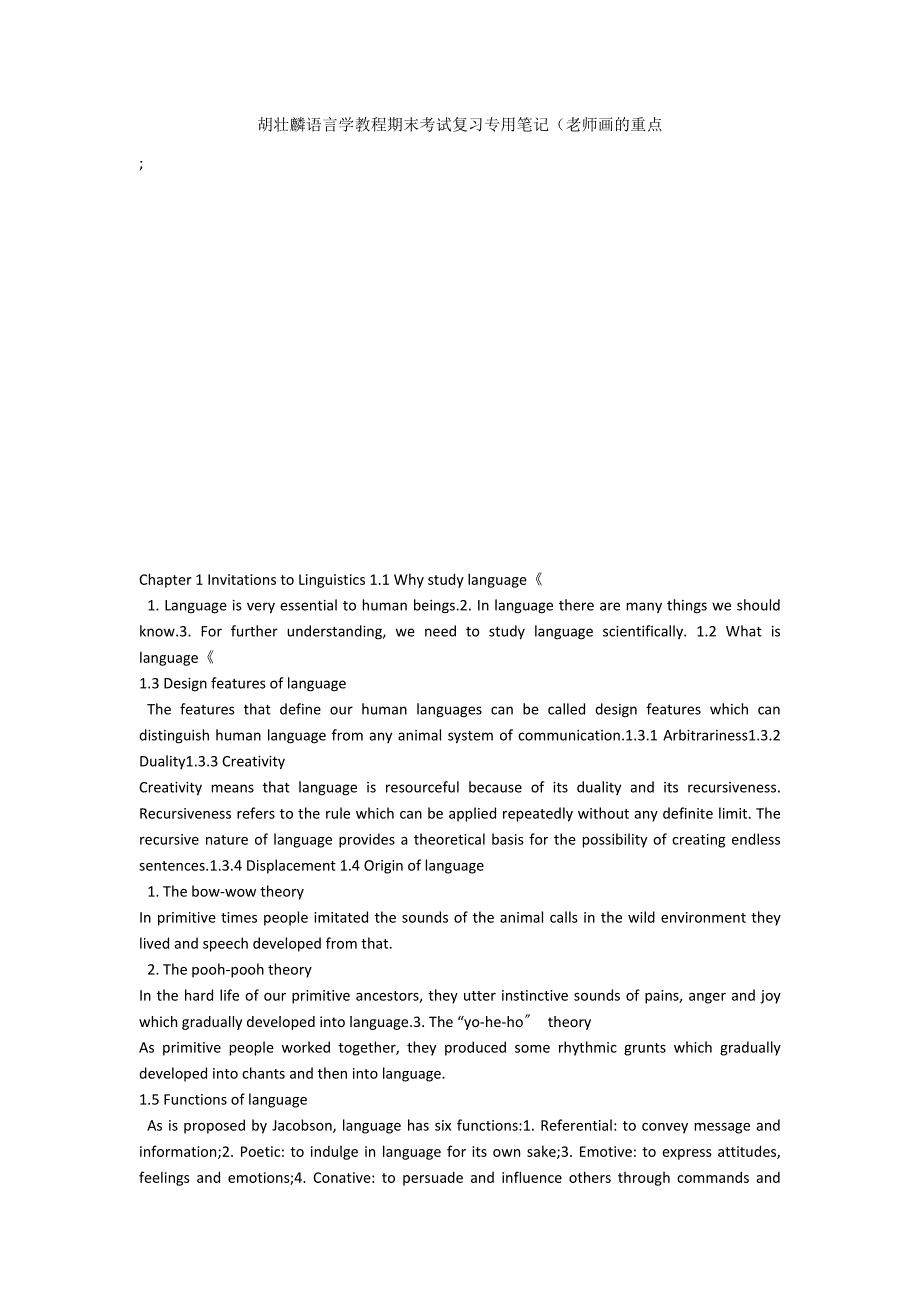 胡壮麟语言学教程期末考试复习专用笔记(老师画的重点
胡壮麟语言学教程期末考试复习专用笔记(老师画的重点



《胡壮麟语言学教程期末考试复习专用笔记(老师画的重点》由会员分享,可在线阅读,更多相关《胡壮麟语言学教程期末考试复习专用笔记(老师画的重点(3页珍藏版)》请在装配图网上搜索。
1、胡壮麟语言学教程期末考试复习专用笔记(老师画的重点; Chapter 1 Invitations to Linguistics 1.1 Why study language 1. Language is very essential to human beings.2. In language there are many things we should know.3. For further understanding, we need to study language scientifically. 1.2 What is language 1.3 Design features of
2、 language The features that define our human languages can be called design features which can distinguish human language from any animal system of communication.1.3.1 Arbitrariness1.3.2 Duality1.3.3 Creativity Creativity means that language is resourceful because of its duality and its recursivenes
3、s. Recursiveness refers to the rule which can be applied repeatedly without any definite limit. The recursive nature of language provides a theoretical basis for the possibility of creating endless sentences.1.3.4 Displacement 1.4 Origin of language 1. The bow-wow theory In primitive times people im
4、itated the sounds of the animal calls in the wild environment they lived and speech developed from that. 2. The pooh-pooh theory In the hard life of our primitive ancestors, they utter instinctive sounds of pains, anger and joy which gradually developed into language.3. The “yo-he-ho theoryAs primit
5、ive people worked together, they produced some rhythmic grunts which gradually developed into chants and then into language.1.5 Functions of language As is proposed by Jacobson, language has six functions:1. Referential: to convey message and information;2. Poetic: to indulge in language for its own
6、 sake;3. Emotive: to express attitudes, feelings and emotions;4. Conative: to persuade and influence others through commands and entreaties; 5. Phatic: to establish communion with others; 6. Metalingual: to clear up intentions, words and meanings. What is contextualism “Contextualism is based on the
7、 presumption that one can derive meaning from, or reduce it to, observable context: the “situational context and the “linguistic context. Every utterance occurs in a particular spatial-temporal situation, as the following factors are related to the situational context: (1) the speaker and the hearer
8、; (2) the actions they are performing at the time; (3) various external objects and events; (4) deictic features. The “linguistic context is another aspect of contextualism. It considers the probability of one words co-occurrence or collocation with another, which forms part of the meaning, and an i
9、mportant factor in communication. Halliday (1994) proposes a theory of metafunctions of language. It means that language has three metafunctions: According to Hu Zhuanglin, language has at least seven functions: 1.5.1 Informative 1.5.2 Interpersonal functionThe interpersonal function means people ca
10、n use language to establish and maintain their status in a society. 1.5.3 PerformativeThe performative function of language is primarily tochange the social status of persons, as in marriage ceremonies, the sentencing of criminals, the blessing of children, the naming of a ship at a launching ceremo
11、ny, and the cursing of enemies.1.5.4 Emotive function1.5.5 Phatic communionThe phatic communion means people always use some small, seemingly meaningless expressions such as Good morning, God bless you, Nice day, etc., to maintain a comfortable relationship between people without any factual content
12、. 1.5.6 Recreational functionThe recreational function means people use language for the sheer joy of using it, such as a babys babbling or a chanters chanting. 1.5.7 Metalingual functionThe metalingual function means people can use language to talk about itself. E.g. I can use the word “book to tal
13、k about a book, and I can also use the expression “the word book to talk about the sign “b-o-o-k itself. 1.6 What is linguistics Linguistics is the scientific study of language. It studies not just one language of any one community, but the language of all human beings.1.7 Main branches of linguisti
14、cs1.7.1 PhoneticsPhonetics is the study of speech sounds, it includes three main areas: articulatory phonetics, acoustic phonetics, and auditory phonetics.1.7.2 PhonologyPhonology studies the rules governing the structure, distribution, and sequencing of speech sounds and the shape of syllables.1.7.
15、3 MorphologyMorphology studies the minimal units of meaning morphemes and word-formation processes.1.7.4 SyntaxSyntax refers to the rules governing the way words are combined to form sentences in a language, or simply, the study of the formation of sentences.1.7.5 SemanticsSemantics examines how meaning is encoded in a language. 1.7.6 Pragmatics Pragmatics is the study of meaning in context.
- 温馨提示:
1: 本站所有资源如无特殊说明,都需要本地电脑安装OFFICE2007和PDF阅读器。图纸软件为CAD,CAXA,PROE,UG,SolidWorks等.压缩文件请下载最新的WinRAR软件解压。
2: 本站的文档不包含任何第三方提供的附件图纸等,如果需要附件,请联系上传者。文件的所有权益归上传用户所有。
3.本站RAR压缩包中若带图纸,网页内容里面会有图纸预览,若没有图纸预览就没有图纸。
4. 未经权益所有人同意不得将文件中的内容挪作商业或盈利用途。
5. 装配图网仅提供信息存储空间,仅对用户上传内容的表现方式做保护处理,对用户上传分享的文档内容本身不做任何修改或编辑,并不能对任何下载内容负责。
6. 下载文件中如有侵权或不适当内容,请与我们联系,我们立即纠正。
7. 本站不保证下载资源的准确性、安全性和完整性, 同时也不承担用户因使用这些下载资源对自己和他人造成任何形式的伤害或损失。
